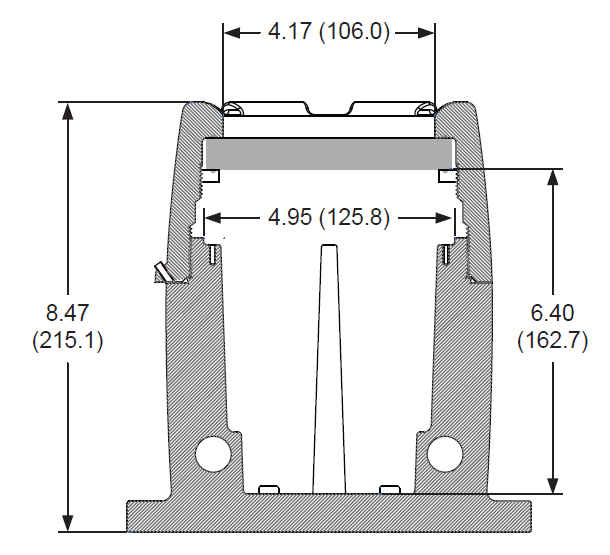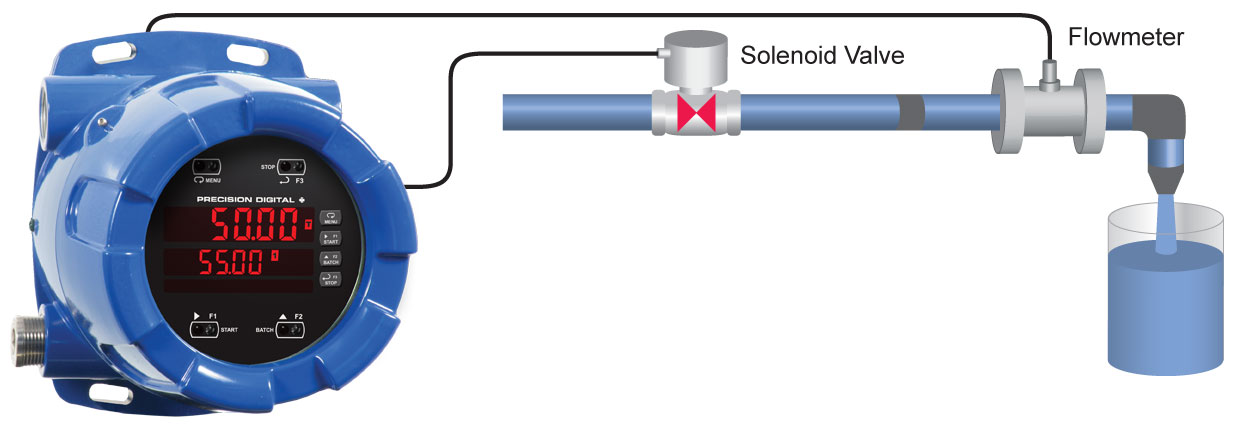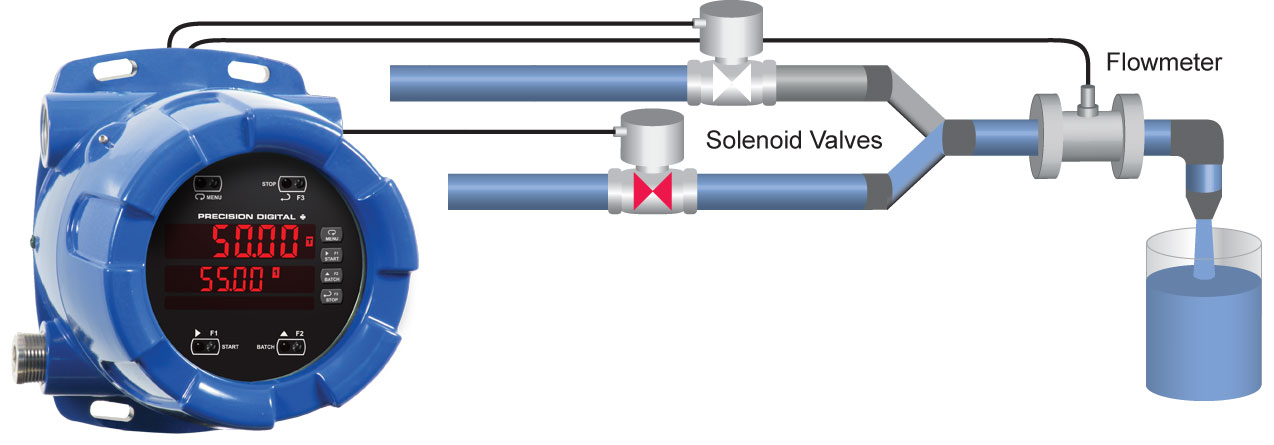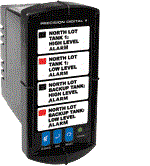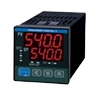General
Display: Upper display: 0.60" (15 mm) high. Lower display: 0.46" (12 mm) high. Both are 6 digits (-99999 to 999999), red LEDs.
Default Display Assignment: The upper display shows batch total. The lower display shows rate with alternating units, and can be switched to show grand total, batch count, or preset with the STOP key.
Custom Display Assignment: The upper and lower displays may be assigned to rate, total, grand total, batch count, preset, set points, units (lower display only), alternating R & T, R & GT, preset & rate, max & min, or a Modbus display register. Any rate/total/grand total display may be programmed to alternate with a custom unit or tag.
Alternating Display: Displays alternate every 10 seconds when display is selected or the batch is paused.
Display Intensity: Eight user selectable intensity levels
Display Update Rate: 5/second (200 ms)
Overrange: Display flashes 999999
Underrange: Display flashes -99999
Programming Methods: Four through-glass SafeTouch buttons, four mechanical buttons behind glass, digital inputs, PC and MeterView Pro software, or Modbus registers.
F4 Digital Input Contacts: 3.3 VDC on contact. Connect normally open contacts across F4 to COM.
F4 Digital Input Logic Levels: Logic High: 3 to 5 VDC; Logic Low: 0 to 1.25 VDC
Noise Filter: Programmable from 2 to 199 (0 will disable filter)
Filter Bypass: Programmable from 0.1 to 99.9% of calibrated span.
Recalibration: Recommended at least every 12 months.
Max/Min Display: Max (Peak) / min (Valley) readings reached by the process are stored until reset by the user or until power is cycled.
Password: Three programmable passwords restrict modification of programmed settings and two prevent resetting the totals.
Non-Volatile Memory: All programmed settings are stored in non-volatile memory for a minimum of ten years if power is lost.
Power Options: 85-265 VAC 50/60 Hz, 90-265 VDC, 20 W max, or optional model with 12-24 VDC ±10%, 15 W max.
Fuse: Required external fuse: UL Recognized, 5 A max, slow blow; up to 6 controllers may share one 5 A fuse.
Isolated Transmitter Power Supply: Terminals P+ & P-: 24 VDC ± 10%. Isolated from the input at >500 V. Jumper selectable for 24, 10, or 5 VDC supply (internal jumper J4). All models transmitter supply rated @ 25mA max.
Normal Rejection Mode: Greater than 60 dB at 50/60 Hz
Isolation: 4 kV input/output-to-power line. 500 V input-to-output or output-to-P+ supply.
Overvoltage Category: Installation Overvoltage Category II: Local level with smaller transient overvoltages than Installation Overvoltage Category III.
Environmental:
T6 Class operating temperature range Ta = -55 to 60°C
T5 Class operating temperature range Ta = -55 to 65°C
Storage temperature range: -55 to 85°C (-67 to 185°F).
Relative humidity: 0 to 90% non-condensing.
Max Power Dissipation: Maximum power dissipation limited to 15.1 W. See PD8 instruction manual for additional details.
Connections: Removable screw terminal blocks accept 12 to 22 AWG wire, RJ45 for external relays, digital I/O, and serial communication adapters.
Mounting: Four slotted flanges for wall mounting or NPS 1½" to 2½" or DN 40 to 65 mm pipe mounting
Dimensions: 6.42" x 7.97" x 8.47" (W x H x D) (163 mm x 202 mm x 215 mm)
Weight: Aluminum: 14.7 lbs (6.67 kg); Stainless Steel: 23.5 lbs (10.66 kg)
Warranty: 3 years parts & labor
USB Connection: Compatibility: USB 2.0 Standard, Compliant
Connector Type: Micro-B receptacle
Cable: USB A Male to Micro-B Cable
Driver: Windows 98/SE, ME, 2000, Server 2003/2008, XP 32/64-Bit,
Vista 32/64-Bit, Windows 7 32/64-Bit, Windows 10 32/64-Bit
Power: USB Port
Pulse Input
Inputs: Field selectable: Pulse or square wave 0-5 V, 0-12 V, or 0-24 V @ 30 kHz; TTL; open collector 4.7 k Ω pull-up to 5 V @ 30 kHz; NPN or PNP transistor, switch contact 4.7 k Ω pull-up to 5 V @ 40 Hz; coil (sine wave) 40 mVp-p min @ 10 kHz; Modbus PV (Slave)
Low Voltage Mag Pickup (Isolated): Sensitivity: 40 mVp-p to 8 Vp-p
Minimum Input Frequency: 0.001 Hz - Minimum frequency is dependent on high gate setting.
Maximum Input Frequency: 30,000 Hz (10,000 for Low Voltage Mag Pickup)
Input Impedance: Pulse input: Greater than 300 kΩ @ 1 kHz. Open collector/switch input: 4.7 k Ω pull-up to 5 V.
Accuracy: 0.03% of calibrated span 1 count
Display Update Rate: Total: 10/sec, Rate: 10/sec to 1/1000 sec
Temperature Drift: Rate display is not affected by changes in temperature.
Multi-Point Linearization: 2 to 32 points
Low-Flow Cutoff: 0-999999 (0 disables cutoff function)
Decimal Point: Up to five decimal places or none: d.ddddd, dd.dddd, ddd.ddd, dddd.dd, ddddd.d, or dddddd.
Calibration: May be calibrated using K-factor, scale using internal calibration, or calibrate by applying an external calibration signal.
K-Factor: Field programmable K-factor converts input pulses to rate in engineering units. May be programmed from 0.00001 to 999,999 pulses/unit.
Calibration Range: Input 1 signal may be set anywhere in the range of the controller; input 2 signal may be set anywhere above setting.
Filter: Programmable contact de-bounce filter, 40 to 999 Hz maximum input frequency allowed with low speed filter.
Time Base: Second, minute, hour, or day
Low Gate: 0.1-99.9 seconds; this function determines how often the incoming pulses are calculated and the rate display is updated.
High Gate: 2.0-999.9 seconds; this function determines how long to wait for pulses before the display goes to zero. This function is used to display slow pulse rates.
Note: The combination of the low and high gate functions makes it possible to have a fast display update for fast pulse rates while displaying slow pulse rates, if needed. For example: If the low gate is set to 1.0 second and the high gate to 999.9 second, with a fast pulse rate the display is updated every second; with a slow pulse rate the controller is capable of waiting up to 999.9 seconds before calculating the rate, making it possible to display a very slow rate down to 1 pulse/999.9 second (0.001 pulse/second).
Batch Controller
Rate Display Indication: 0 to 999999, lead zero blanking. "R" LED illuminates while displaying rate.
Total Displays & Grand Total Overflow: 0 to 999,999; automatic lead zero blanking. "T" LED is illuminated while displaying batch total and "GT" for grand total. Up to 999,999,999 with total-overflow feature. " " is displayed to the left of grand total overflow and
" is displayed to the left of grand total overflow and  LED is illuminated.
LED is illuminated.
Batch Total Decimal Point: Up to five decimal places or none: d.ddddd, dd.dddd, ddd.ddd, dddd.dd, ddddd.d, or dddddd. Total decimal point is independent of rate decimal point.
Totalizer: Calculates total based on rate and field programmable multiplier to display total in engineering units. Time base must be selected according to the time units in which the rate is displayed.
Total Conversion Factor: 0.00001 to 999,999
Batch Preset: 0.00001 to 999,999 based on batch total decimal point.
Automatic Batch Restart Delay: 00000.1 to 999.9 seconds. The batch will automatically restart after completion of the last batch.
Grand Total Rollover: Totalizer rolls over when display exceeds 999,999,999. Relay status reflects the display value.
Grand Total Alarms: Up to seven, user selectable under Setup menu. Any set point can be assigned to grand total and may be programmed anywhere in the range of the controller for grand total alarm indication.
Note that Relay 1 should always be assigned to batch control (total).
Grand Total Reset: Via front panel button, external contact closure on digital inputs, automatically via user selectable preset value and time delay, or through serial communications.
Grand Total Reset Password: A grand total password may be entered to prevent resetting the grand total from the front panel.
Non-Resettable Grand Total: The grand total can be programmed as a non-resettable total by entering the password "050873".
Caution: Once the Grand Total has been programmed as "non-resettable" the feature cannot be disabled.
Relays
Rating: 4 SPDT (Form C) internal and/or 4 SPST (Form A) external; rated 3 A @ 30 VDC and 125/250 VAC resistive load; 1/14 HP (≈ 50 W) @ 125/250 VAC for inductive loads
Noise Suppression: Noise suppression is recommended for each relay contact switching inductive loads.
Relay Assignment: Relays may be assigned to batch control, sampling, rate, or grand total alarms.
Preclose: 0-100% of batch size, individually user programmable for each additional batch control relay beyond the first.
Alarm Deadband: 0-100% of span, user programmable
High or Low Alarm: User may program any alarm for high or low trip point. Unused alarm LEDs and relays may be disabled (turned off).
Batching Relay Operation: Single or (2 to 8) multi-relay batching with optional preclose for multi-stage operation. Each additional relay may be programmed with an individual preclose value.
Alarm Relay Operation: Automatic (non-latching), latching (requires manual acknowledge), sampling (based on rate or grand total), pump alternation control (2 to 8 relays), off (disable unused relays), and manual on/off control mode. Alarms are active only when the batch is running.
Alarm Relay Reset: User selectable via front buttons, digital inputs, or PC
1. Automatic reset only (non-latching), when input passes the reset point or total is reset to zero.
2. Manual reset only, when batch is stopped (latching).
3. Manual reset only after alarm condition has cleared (latching)
Note: Front panel button or digital input may be assigned to acknowledge relays programmed for manual reset. This replaces one of the standard batch control function keys. Only the PAUSE/STOP key function is possible during a batch process, so manual reset may only be done when thecontroller is in STOP mode.
Deadband: 0-100% of span, user programmable
Time Delay: 0 to 999.9 seconds, on & off relay time delays. Programmable and independent for each relay.
Fail-Safe Operation: Programmable and independent for each relay.
Note: Relay coil is energized in non-alarm condition. In case of power failure, relay will go to alarm state.
Auto Initialization: When power is applied, relays will reflect the state of the input. Alarms are active only when the batch is running.
Isolated 4-20 mA Transmitter Output
Output Source: Rate/process, total, grand total, max, min, set points 1-8, manual control setting, or Modbus input
Scaling Range: 1.000 to 23.000 mA for any display range
Calibration: Factory calibrated: 4.000 to 20.000 = 4-20 mA output
Analog Output Programming: 23.000 mA maximum for all parameters: Overrange, underrange, max, min, and break
Accuracy: ±0.1% FS ±0.004 mA
Temperature Drift: 0.4 µA/°C max from 0 to 65°C ambient, 0.8 µA/°C max from -40 to 0°C ambient Note: Analog output drift is separate from input drift.
Isolated Transmitter Power Supply: Terminals I+ & R: 24 VDC ± 10%. Isolated from the input at >500 V. May be used to power the 4-20 mA output or other devices. All models @ 25 mA max.
External Loop Power Supply: 35 VDC maximum
Output Loop Resistance:
| Power supply | Minimum | Maximum |
| 24 VDC | 10 Ω | 700 Ω |
| 35 VDC (external) | 100 Ω | 1200Ω |
Serial Communications
Compatability: EIA-485
Connectors: Removable screw terminal connector
Max Distance: 3,937' (1,200 m) max
Status Indication: Separate LEDs for Power (P), Transmit (TX), and Receive (RX)
Protocol: Modbus® RTU
Controller Address/Slave ID: 1 - 247
Baud Rate: 300 - 19,200 bps
Transmit Time Delay: Programmable between 0 and 199 ms or transmitter always on for RS-422 communication
Data: 8 bit (1 start bit, 1 or 2 stop bits)
Parity: Even, odd, or none with 1 or 2 stop bits
Byte-to-Byte Timeout: 0.01 - 2.54 seconds
Turn Around Delay: Less than 2 ms (fixed)
Note: Refer to the PD6000/PD7000 Modbus Register Tables located in the documentation section of this page.
Digital Inputs and Outputs
Channels: 4 digital inputs & 4 digital outputs per module
System: One expansion module may be added for a total of 8 inputs & 8 outputs
Note: The jumper located between the RJ45 connectors must be removed on the expansion module.
Digital Input Logic: High: 3 to 5 VDC; Low: 0 to 1.25 VDC
Digital Output Logic: High: 3.1 to 3.3 VDC; Low: 0 to 0.4 VD
Source Current: 10 mA maximum output current
Sink Current: 1.5 mA minimum input current
+5 V Terminal: To be used as pull-up for digital inputs only. Connect normally open pushbuttons across +5 V & DI 1-4. Warning: DO NOT use +5 V terminal (pin 1) to power external devices.
Function Assignment: The on-board digital inputs (1-4) are designed to mimic the behavior of the front panel buttons (Menu, F1, F2, & F3). If you wish to change their behavior, re-assign F1-F3 to the desired function, then change the corresponding digital input to match.
Enclosure
| Material | -AL Models: ASTM A413 LM6 die-cast aluminum, copper-free, enamel coated
-SS Models: ASTM A743 CF8M investment-cast 316 stainless steel |
| Gasket | Fluoroelastomer |
| Rating | NEMA 4X, IP68 Explosion-proof |
| Color | -AL: Blue
-SS: Silver |
| Window | Borosilicate glass |
| Conduits | Four ¾" NPT threaded conduit openings |
| Conduit Stopping Plugs | Sold separately |
| Flanges | Two built-in flanges for wall and pipe mounting. |
| Tamper-Proof Seal | Cover may be secured with tamper-proof seal. |
| Overall Dimensions | 6.42" x 7.97" x 8.47" (W x H x D)
(163 mm x 202 mm x 215 mm) |
| Weight | AL: 14.7 lbs (6.67 kg)
SS: 23.5 lbs (10.66 kg) |
| ATEX | Flameproof
 II 2GD II 2GD
Ex db IIC Gb
Ex tb IIIC Db
IP66/IP68
Tamb: -55°C to +85°C
Certificate No.: Sira 19ATEX1252U |
| IECEx | Flameproof and dust protection
Ex db IIC Gb
Ex tb IIIC Db
IP66/IP68
Tamb: -55°C to +85°C
Certificate No.: IECEx SIR 19.0075U |
| CSA | Class I, Division 1, Groups A, B, C, D
Class II, Division 1, Group E, F, G
Class III
Ex db IIC Gb
Ex tb IIIC Db
Class I, Zone 1, AEx db IIC Gb
Zone 21, AEx tb IIIC Db
IP66/IP68/TYPE 4X
Tamb: -55°C to +85°C
Certificate No.: 80011200 |
| UL | Class I, Division 1, Groups A, B, C, D
Class II, Division 1, Groups E, F, G
Class III
Class I, Zone 1, AEx db IIC Gb
Zone 21, AEx tb IIIC
Ex db IIC Gb
Ex tb IIIC Db
IP66/IP68/TYPE 4X
Tamb: -55°C to +85°C
Certificate Number: E518920 |
| Note: The above approvals are for the enclosure only. See below for approvals on the entire instrument. |
General Compliance Information
Electromagnetic Compatibility
| Emissions | EN 55022
Class A ITE emissions requirements |
| Radiated Emissions | Class A |
| AC Mains Conducted Emissions | Class A |
| Immunity | EN 61326-1
Measurement, control, and laboratory equipment
EN 61000-6-2
EMC heavy industrial generic immunity standard |
| RFI - Amplitude Modulated | 80 -1000 MHz 10 V/m 80% AM (1 kHz)
1.4 - 2.0 GHz 3 V/m 80% AM (1 kHz)
2.0 - 2.7 GHz 1 V/m 80% AM (1 kHz) |
| Electrical Fast Transients | ±2kV AC mains, ±1kV other |
| Electrostatic Discharge | ±4kV contact, ±8kV air |
| RFI - Conducted | 10V, 0.15-80 MHz, 1kHz 80% AM |
| AC Surge | ±2kV Common, ±1kV Differential |
| Surge | 1KV (CM) |
| Power-Frequency Magnetic Field | 30 A/m 70%V for 0.5 period |
| Voltage Dips | 40%V for 5 & 50 periods
70%V for 25 periods |
| Voltage
Interruptions | <5%V for 250 periods |
| Note: Testing was conducted on meters with cable shields grounded
at the point of entry representing installations designed to optimize
EMC performance. |
Product Ratings and Approvals
| CSA | Class I, Division 1, Groups B, C, D
Class II, Division 1, Groups E, F, G
Class III, Division 1
Class I Zone 1 Ex db IIC
Zone 21 Ex tb IIIC T90°C
-55°C < Tamb. < +60° C; Temperature Code T6
-55°C < Tamb. < +65° C; Temperature Code T5
Enclosure Type 4X & IP66 / IP68
Certificate Number: 2531731 |
| ATEX | II 2 G D
Ex db IIC T* Gb
Ex tb IIIC T90°C Db IP68
Ta = -55°C to +*°C
*T6 = -55°C to +60°C
*T5 = -55°C to +65°C
Certificate Number: Sira 12ATEX1182X
|
| IECEx | Ex db IIC T* Gb
Ex tb IIIC T90°C Db IP68
Ta = -55°C to +*°C
*T6 = -55°C to +60°C
*T5 = -55°C to +65°C
*T5 = -55°C to +65°C
Certificate Number: IECEx SIR 12.0073X
|
ATEX/IECEx Specific Conditions of Use:- The equipment label and epoxy coating may
generate an ignition-capable level of electrostatic
charges under certain extreme conditions. The
user should ensure that the equipment is not
installed in a location where it may be subjected
to external conditions (such as high-pressure
steam) which might cause a build-up of
electrostatic charges on non-conducting
surfaces. Additionally, cleaning of the equipment
should be done only with a damp cloth.
- Flameproof joints are not intended to be repaired.
- All entry closure devices shall be suitably certified
as “Ex d”, “Ex t” and “IP66/68” as applicable.
Suitable thread sealing compound (non-setting,
non-insulating, non-corrosive, not solvent based,
suitable for the ambient rating) must be used at
the NPT conduit entries to achieve the IPx8
rating while maintaining the Ex protection
concept.
Year of ConstructionThis information is contained within the serial number
with the first four digits representing the year and
month in the YYMM format.
For European Community:The ProtEX-MAX must
be installed in accordance with the ATEX directive
2014/34/EU, and the product certificate Sira
12ATEX1182X.
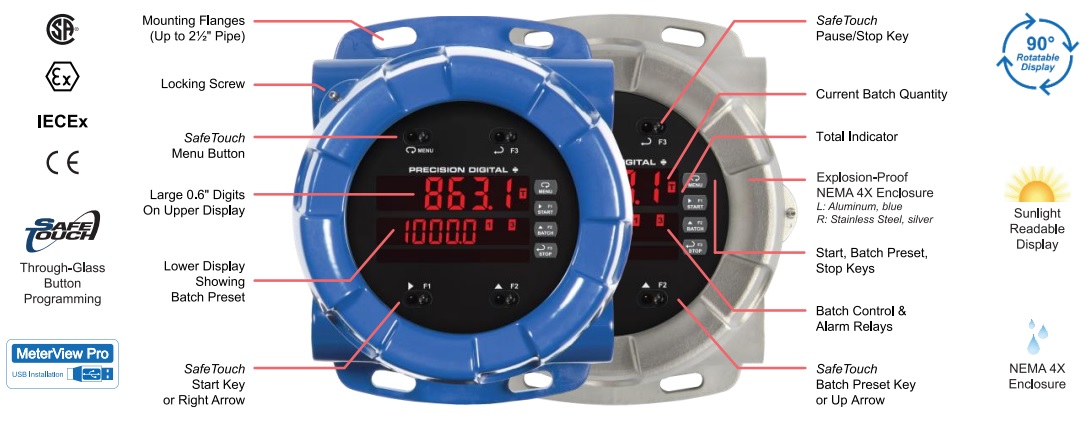
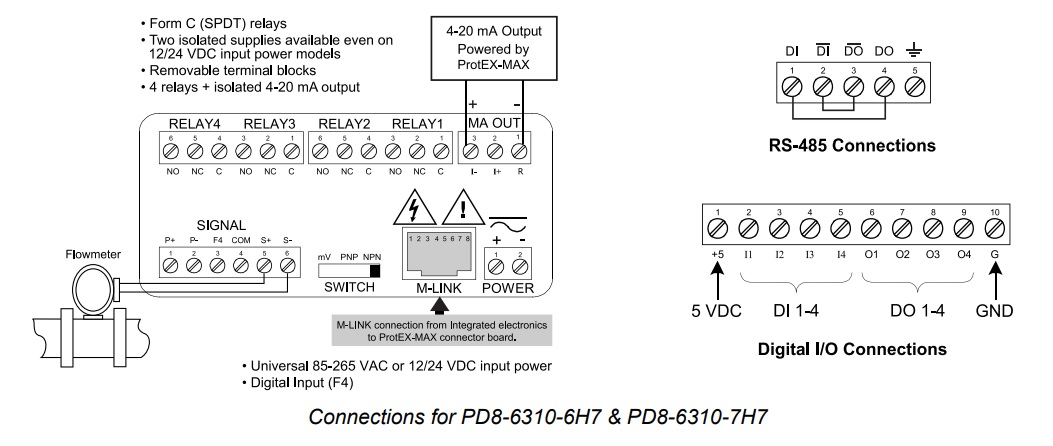

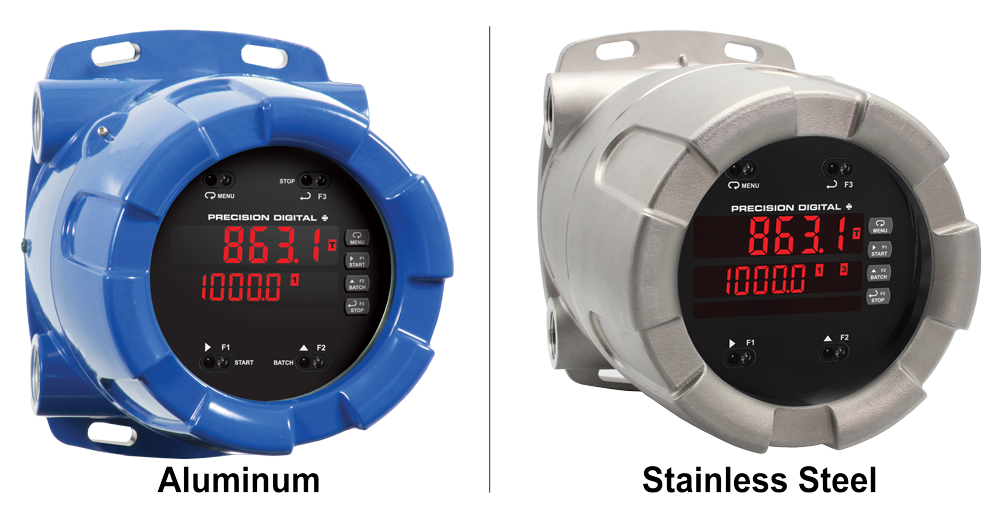
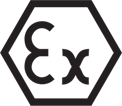






 " is displayed to the left of grand total overflow and
" is displayed to the left of grand total overflow and  LED is illuminated.
LED is illuminated.
